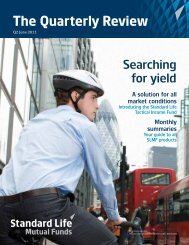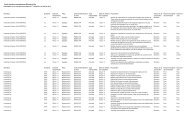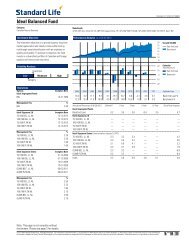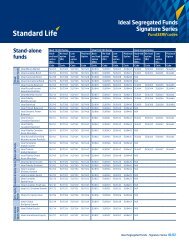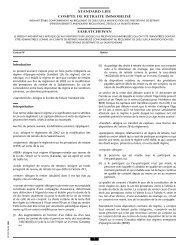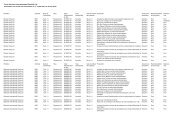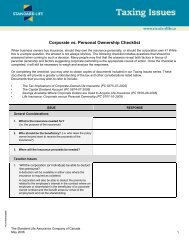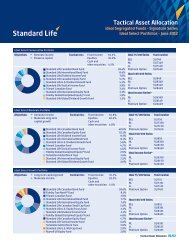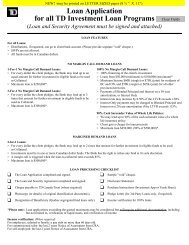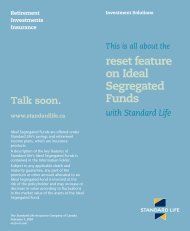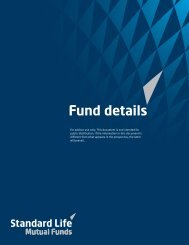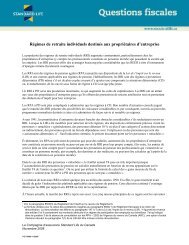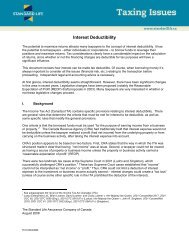Leveraged Supplementary Retirement Account - Standard Life
Leveraged Supplementary Retirement Account - Standard Life
Leveraged Supplementary Retirement Account - Standard Life
Create successful ePaper yourself
Turn your PDF publications into a flip-book with our unique Google optimized e-Paper software.
<strong>Leveraged</strong> <strong>Supplementary</strong> <strong>Retirement</strong> <strong>Account</strong><br />
Sources of retirement income<br />
Three ways to access investment accounts in retirement<br />
4. Using a <strong>Leveraged</strong> <strong>Supplementary</strong><br />
<strong>Retirement</strong> <strong>Account</strong> (LSRA) to fund<br />
retirement<br />
This strategy involves purchasing a universal<br />
life (UL) insurance policy generally a minimum<br />
of 10 years prior to retirement. Policies that<br />
qualify as “exempt” under the ITA (most UL<br />
policies issued in Canada qualify), allow funds<br />
to accumulate within an investment account<br />
inside the policy on a tax-sheltered basis by<br />
virtue of sections 148 and 12.2 of the ITA.<br />
The other component of the policy is the life<br />
insurance component. It is separate from the<br />
investment, but both form part of the same life<br />
insurance policy.<br />
What makes universal life insurance attractive<br />
is premium flexibility. A client can deposit more<br />
or less into the plan, as long as there is enough<br />
to cover the premiums for the life insurance<br />
component. Excess contributions (up to a<br />
maximum limit calculated with reference to ITA<br />
rules) form part of the investment account in the<br />
policy that can grow on a tax-sheltered basis.<br />
Upon the death of the insured, the total death<br />
benefit is paid out tax-free to the beneficiary(ies).<br />
Tax may be payable if the policy is disposed of<br />
and the investment funds withdrawn, in whole<br />
or in part, before the death of the life insured.<br />
Three ways to access the<br />
investment accounts in<br />
retirement:<br />
1. Withdrawals from the policy<br />
2. Policy loans from the insurance company<br />
3. Collateralization with a financial institution<br />
Withdrawal from the policy<br />
Withdrawals can be made directly from the life<br />
insurance policy’s cash surrender value. When<br />
a partial withdrawal is made, the adjusted cost<br />
basis (ACB) may have an impact on the net<br />
amount withdrawn as the difference between the<br />
amount withdrawn and the ACB is taxable. The<br />
amount of the ACB is proportional to the total<br />
amount withdrawn.<br />
Policy loans<br />
Funds can also be accessed as a policy loan.<br />
In essence, these are not typical loans, but<br />
rather advance payments of the policyholder’s<br />
entitlement under the policy. The advances do<br />
not have to be repaid to the insurer. A policy loan<br />
constitutes a disposition for tax purposes and<br />
will attract taxation when the total loan amount<br />
exceeds the adjusted cost basis of the policy.<br />
The insurance company will charge interest on<br />
any outstanding balance of policy loan. Any<br />
outstanding loan balance will be deducted<br />
from the policy proceeds at death with the net<br />
amount then being paid to the beneficiary(ies).<br />
For additional information on this topic, please<br />
refer to the Taxing Issues document entitled<br />
“Policy Loans” (PC 6140).<br />
Collateralization with a financial<br />
institution<br />
Another way to access the account value of the<br />
life insurance policy is by pledging the policy<br />
as collateral for a loan or series of loans from a<br />
financial institution. At retirement, the policy may<br />
be used as collateral security, and the financial<br />
institution will grant yearly loans or a lump sum,<br />
which can provide an additional source of yearly<br />
income to meet needs in retirement. Based on<br />
current tax rules (as at November, 2007) the loan<br />
proceeds are not taxable.<br />
<strong>Standard</strong> <strong>Life</strong> 5



